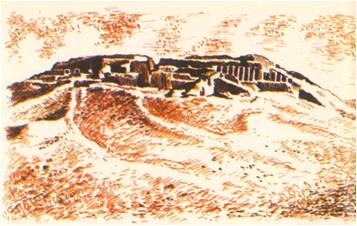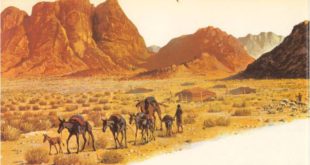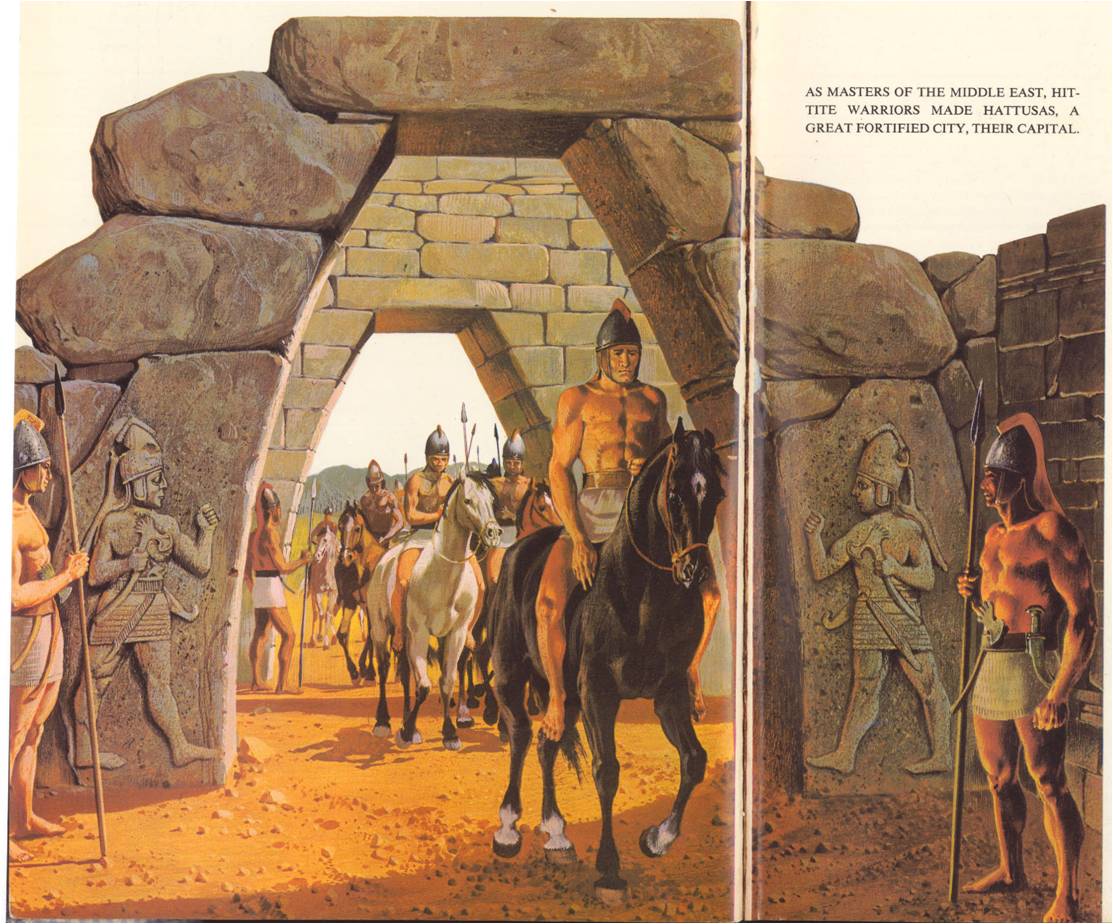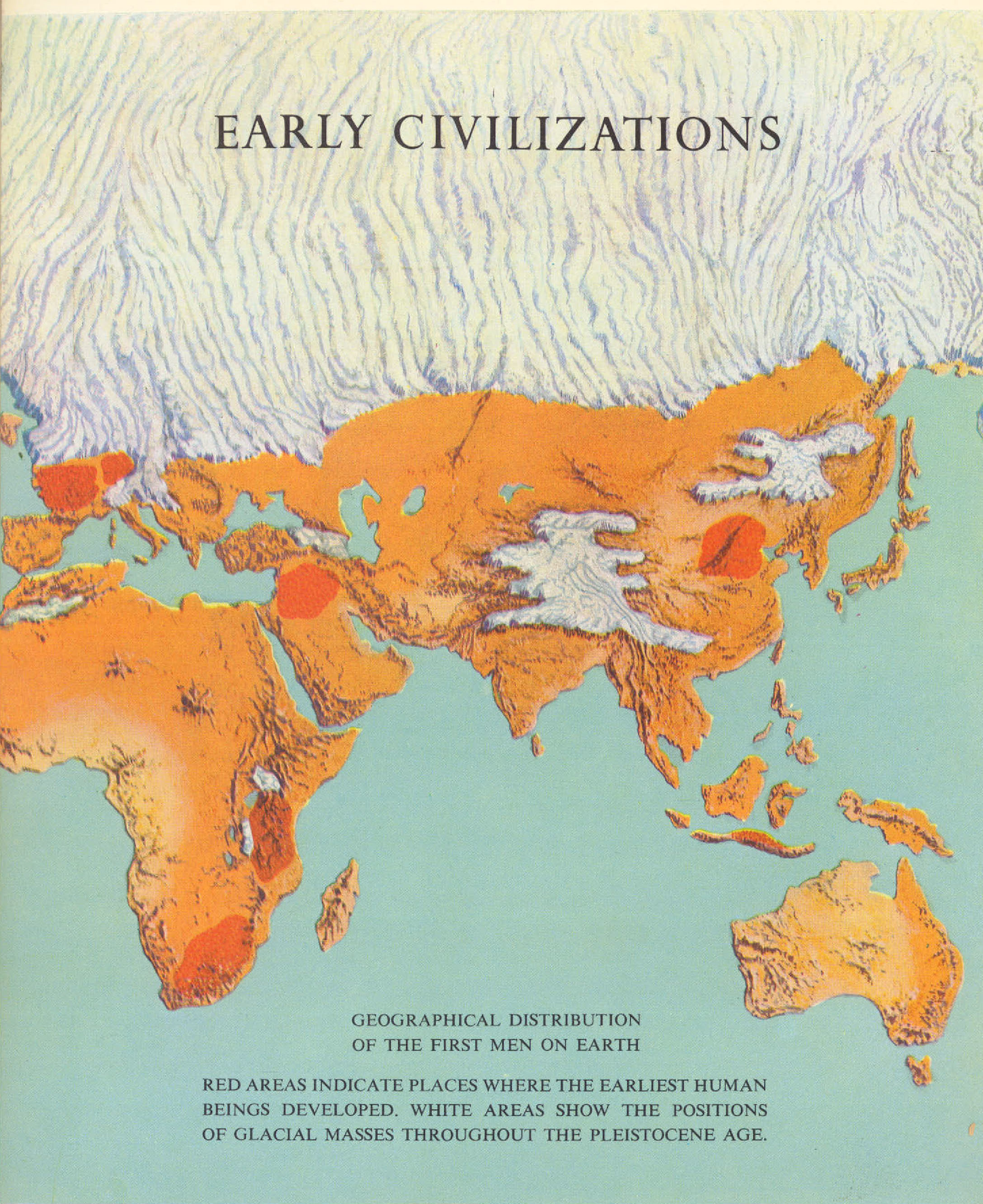For many generations, the ancestors of P’an Keng had considered themselves kings in northern China. Yet this family of kings, the Shang Dynasty, had never governed from a central capital. About 1380 B. C., P’an Keng decided it was time to set up a capital. He found what seemed to be the perfect site at Anyang. Situated near a bend in China’s Yellow River, the fertile plains were ideal for farming and pasture, while the mountains behind it had timber and wild game. Only one thing remained: P’an Keng had to find out if the move was approved by the gods and his ancestors. P’an Keng sent for a diviner, one of the wise men who could read the will of the spirits. Everyone consulted the diviners for help in making decisions, whether it was the king planning a battle or a farmer wanting to know when to plant. Usually the diviner used animal bones in which small oval pits had been drilled. The diviner would heat a bronze rod in a fire and touch its point to the side of a pit. The heat cracked the bone slightly and by examining the size and angles of the cracks, the diviner interpreted the message of the spirits. For special occasions in China, the diviner used a large piece of tortoise shell in place of bones and the choice of the capital was such an occasion. P’an Keng began to ask his questions, “should the capital be set up at Anyang?” “Was the dream a good sign?” “Does Shang Ti, the great god approve?” “Will Tang, founder of the Shang Dynasty, aid this move?” P’an Keng was overjoyed to hear the diviner interpret the answer to each question as “Yes” or “Fortunate”. This meant that the spirits approved. Since this was …
Read More »Civilization comes to India 3500 B.C to 200 B.C.
For thousands of years during the Stone Age, only scattered groups of people had lived in India. With only the simplest tools of bone, wood and stone, they hunted and gathered food. Cut off from other peoples by the mountain and the sea, the first Indians made few advances in their primitive way of life. Then, sometime between 3500 B. C., new settlers began to appear along the Indus River Valley in northwestern India, a region that would be called West Pakistan thousands of years later. It seems almost certain that these newcomers were from the mountains and plateaus to the northwest, the modern lands of Iran and Afghanistan. When they arrived, the new commers were already able to make pottery, to farm and to raise animals. Most likely too, some of them knew of the cities far to the west, on the plains of Mesopotamia. From those more advanced cities, the Indus valley people learned about new objects, such as copper and bronze tools. They also heard tales about how those distant peoples controlled the river’s water, or how they scratched signs in clay tablets to record words. However much they may have borrowed, the Indus Valley people worked out their own ways. By 2500 B. C., a distinctive civilization had begun to develop along the Indus River. The river itself played an important part in this civilization. Sometimes it flooded so badly that it wiped out villages and fieldworks, or even changed its course entirely. Usually however, it overflowed just enough to leave a rich soil for each season’s crops and the people worked together to take advantage of it. The river also made it easy for the various settlements to exchange goods and ideas. The People of the Indus Of the dozens of villages, two soon grew …
Read More »A New People, a New Faith 650 B. C. – 330 B. C
BABYLON, the final capital of Mesopotamia civilization, had fallen to warrior tribesmen from the east, the Medes and Persians. The Medes and Persians were descended from the Aryan peoples who for centuries had been moving out of the grasslands of central Asia with their horses and herds. Some of the Aryans settled in the valleys and slopes of the mountains surrounding the great arid plateau between the Persian Gulf and the Caspian Sea. From them the region took its name, Iran, or Land of the Aryans. The Aryans who lived in the mountains northeast of Mesopotamia were the Medes, familiar to their prosperous neighbours as breeders of horses and as raiders of cities and trade caravans. Other Aryans settled south of the Medes, in the region of Parsa along the valleys, foothills and plains of the Zagros Mountains and these people became known as Persians. About 650 B. C., one of the Persian chieftains, Achaemenes, organized a small kingdom. His descendant, Cyrus, later brought the various tribes of Persians and Medes under his rule and led the united forces into Babylon. Before Cyrus formed the Persian nation, a man appeared who would influence the Persians in another way. He was Zoroaster or Zarathustra, who around 600 B. C. began to preach a new religion to the people of Iran. The Aryans had always worshipped many gods, especially Mithra the sun god and they often sacrificed animals. The priests who supervised the many rituals became a privileged group. Among the Medes, these priests were known as the Magi. Zoroaster introduced no new rituals and started no new priesthood; he was a prophet and reformer. Zoroaster was most active in eastern Iran, perhaps as a priest of the old Aryan religion, but he soon withdrew from society and went to live on …
Read More »The Rise of the Assyrians 1600 B. C. – 539 B. C.
During the century after the Hittites had raided Babylon and rose to power in Turkey and Syria, Mesopotamia was a divided unproductive land. In the south, Babylonia fell under the rule of foreigners, first the Kassites from the northeast and then the Elamites from the southeast. Neither of these people seemed able to make any advances in civilization. Northern Mesopotamia came under the Mitanni kingdom, which at least introduced trained horses and chariots to the Near East. By the time the native Babylonians regained control and the Mitanni kingdom fell, another people was disturbing the land – the Assyrians. The Assyrians who wrote and spoke Akkadian, were close relatives of the Babylonians and had played a minor part in Mesopotamian affairs for some time. They made their home in the upper reaches of the Tigris River, where once had been some of the earliest farming communities in the world. The region later came under the influence of various early Sumerian and Babylonian kingdoms to the south. By about 2000 B. C., the Assyrians themselves became independent enough to carry on a thriving trade with people in Turkey. But around 1800 B. C. the Hittites put an end to that and then the Mitanni kingdom set itself over Assyria. The Warrior Kings Centuries passed and the Assyrians overthrew a weakened Mitanni kingdom, but even before this they were struggling with Babylonia for control of Mesopotamia. Year after year, lands, cities, trading routes and outposts changed hands, until the Assyrians gradually won out. By 1100 B. C., under their king Tiglath-Pileser I, the Assyrians were strong enough to begin expanding. Fighting off enemies on all sides, Assyria began to dominate the metal trade with the north and the commercial centres of the Syrian coast. Loot and tribute made Ashur, the capital of …
Read More »The People of One God 3000 B. C. – 30 B. C.
On the plains of Mesopotamia, a young man stood gazing up at the stars that glittered from the dark sky of night. He was Abraham, a native of the Sumerian city of Ur. Abraham was a Hebrew, one of the many tribes of Semites said to have been descended from Shem, the son of Noah who had been saved from a great flood many years before. Like all people of his time, Abraham believed in many gods throughout nature. As he studied the pattern of the great stars for the god’s message, Abraham began to feel he was in the presence of a Lord God who was above all gods with idols and temples and sacrifices. Abraham felt, too, that this Lord God would take special care of those who lived up to his demands. Abraham became so devoted to this idea that years later he was inspired to leave Mesopotamia and start a new nation whose people would worship only the Lord God. With his family and tents and flocks, he made his way westward to the land of Canaan. After many setbacks, Abraham died there, content to know that his son Isaac would carry on the family. Isaac prospered and was followed by his son Jacob, whose life was such a struggle that he was honoured with the name Israel, meaning “struggler of god”. Jacob had twelve sons, each of whom founded a tribe and they and all their descendants became known as Israelites. One of Jacob’s sons, Joseph, became an important official in the Egyptian court and when a famine in the land of Canaan threatened to wipe out the Hebrews, they all joined Joseph in Egypt. This was the story told in the Bible and the traditions of the people who honoured Abraham, Isaac and Jacob …
Read More »The Gift of the Nile 3300 B.C. – 30 B.C.
It was around 3500 B.C. and as it did every year around the middle of July, the Nile had begun to rise. Carrying tons of soil, the waters poured down from the mountains of Africa, where the rain and melting snow fed the streams that surfed northward into one great river. Wherever it ran free of the rocky canyons, the river overflowed onto the dry fields along its banks. It lapped against the villages on high ground and spread to market towns on the edges of the dessert. Moving northward, the river engulfed the entire Delta region and then emptied into the Mediterranean Sea. By mid-November the waters receded, leaving a thick, dark mud on the fields and in the canals. Near one of the largest towns far up the Nile, the farmers stood waiting at the edge of the fields. Then from the town came the king, followed by guards, priests and servants carrying large fans. The king wore a high white crown and carried a hoe. Scooping some fresh mud out of an irrigation ditch, he placed it in a basket held by an attendant. While the priests chanted, the mud was spread over the field. Now the farmers could plant in the fertile earth left by the floodwaters. The king, who was responsible for the well-being of his people, had performed a great duty. As his white crown indicated, this king ruled only in Upper Egypt. In the Delta to the North there was another king, who wore a red crown. For many years the people of Lower and Upper Delta had been fighting and raiding each other’s towns. However, they all had common ancestors who had come from Africa to the south, from Libya to the west and from Asia to the north and east. Through …
Read More »Hittite Warriors Build a Kingdom 1750 B. C. – 700 B. C.
Within 150 years of the death of Hammurabi, the cities of Mesopotamia were powerless and other peoples took up the struggle for the Near Eastern world. Among them were the Hittites, who had taken the city of Babylon. The rough Hittite tribesman hardly knew what to do with such a splendid city, let alone with an empire, so they went back to their strongholds in the highland plains of central Turkey. They had been living there for several centuries, ever since they had left their homeland in the steppes of central Asia. When the Hittites first moved into Turkey, they had found a land of peasants and small city-states unable to unite in resistance. The Hittites allowed the people to keep their own gods and languages, recruited officials to manage affairs and left the farmers and craftsmen to their work. It was a bleak, rocky land, hot and dry in summer, cold and windswept in winter but, there were grains and cattle and the people made beer and wine and kept bees for honey. The land was rich in metal ores, too. Later the Hittites were among the first to use iron. The Hittites set themselves over the native peoples as an aristocratic warrior class. For many years, rival Hittite tribes and chieftains fought among themselves before Labarnas established himself as the first true king. He led the Hittites in expanding their power throughout Turkey and his son Hattusilis I, extended it to Syria. Hattusilis made the city of Hattusas his capital. It was strategically located near the crossroads of the main trade routes in central Turkey. As his reign neared its end, Hattusilis could take pride in the kingdom he was leaving to his people, but he had one unpleasant task to perform. He had raised his nephew as …
Read More »Mesopotamia, Where Civilization Began 4000 B.C. – 1750 B.C.
Mesopotamia is where civilization began. By 4000 B. C., many different groups of people were working out their lives in a variety of ways. In a great arc from the eastern coast of the Mediterranean, across the Turkish plains and through the highlands of Iraq and Iran, groups of peoples had settled and were farming, tending animals, making pottery and building towns, markets and forts. In the deserts, mountains and steppes, nomadic tribesmen lived by herding animals and by hunting and raiding. In Mesopotamia as these populations grew, they began to compete for land, food and supplies. One of the areas that was to become most sought after was a stretch of land almost at the very centre of these various peoples. It was only about 150 miles wide and 600 miles long and extended from the foothills of northwester Iraq to the Persian Gulf. Two rivers, the Tigris and the Euphrates, drained the area and gave it its name, Mesopotamia – “the land between the rivers”. For the next 3,500 years, Mesopotamia was to witness the rise and fall of many cities and cultures. Sumerians, Akkadians, Babylonians, Assyrians, Chaldaeans – these were only some of the people who took root and flourished in this land. Finally the Persians came and reduced Mesopotamia to a mere province but from the first unknown settlers to the mighty Nebuchadnezzar, this land gave rise to much that would affect all civilization. The first settlers in Mesopotamia set up their villages and farmed in the upper reaches of the Tigris. These were among the earliest farming communities anywhere in the world, but they gradually declined and it was many years later before this region came to be known as Assyria. Mesopotamia’s southern region, which was later called Babylonia, was especially hot and dry and …
Read More »The Coming of Man
About 400,000 years ago, a group of people were gathered at the mouth of a cave. They had a fire in which they were roasting deer meat and around them lay the bones of monkeys, wild pigs and water buffalo from previous meals. One of the women was picking berries from the nearby bushes. A man sitting close to the fire chipped away at a broken stone he would use to cut off chunks of the cooked meat. Another man, too hungry to wait, gnawed the marrow from some bones. The cave was one of several not far from what is now Peking, China and the people who first used these caves are known as Peking Man. Peking Man did not leave anything behind except some bones, charcoal, berries and stones, but these are enough to suggest certain things about the way he lived. They show that the people at the caves ate meat as well as plants, made crude tools, could kill large animals and knew how to keep a fire alive. With fire they could keep warm and fend off wild animals at night. Probably they cooked some foods in the fire. Instead of eating in the fields after killing an animal, the men might wait until they gathered around the fire to eat. Such a meal became something of a family or group occasion. There was a sharing of tasks, of food, of pleasures. No one said much, but with simple language the adults could pass on something of what they had learned to their children. At times, when food was scarce these people may have eaten human flesh, but it is likely they killed only to survive. Or perhaps they believed by eating human flesh they could obtain the strength of a slain enemy, or keep …
Read More »








